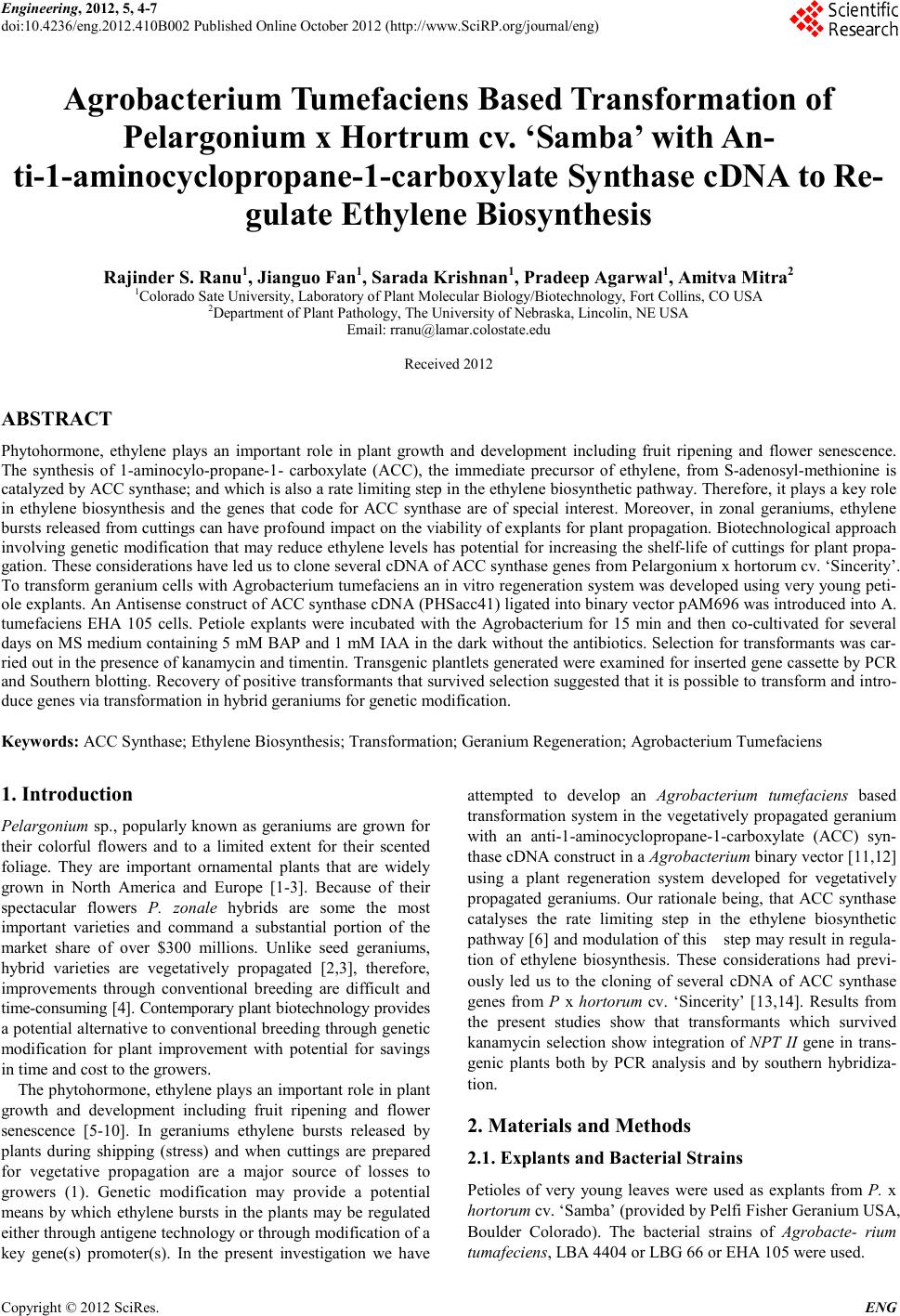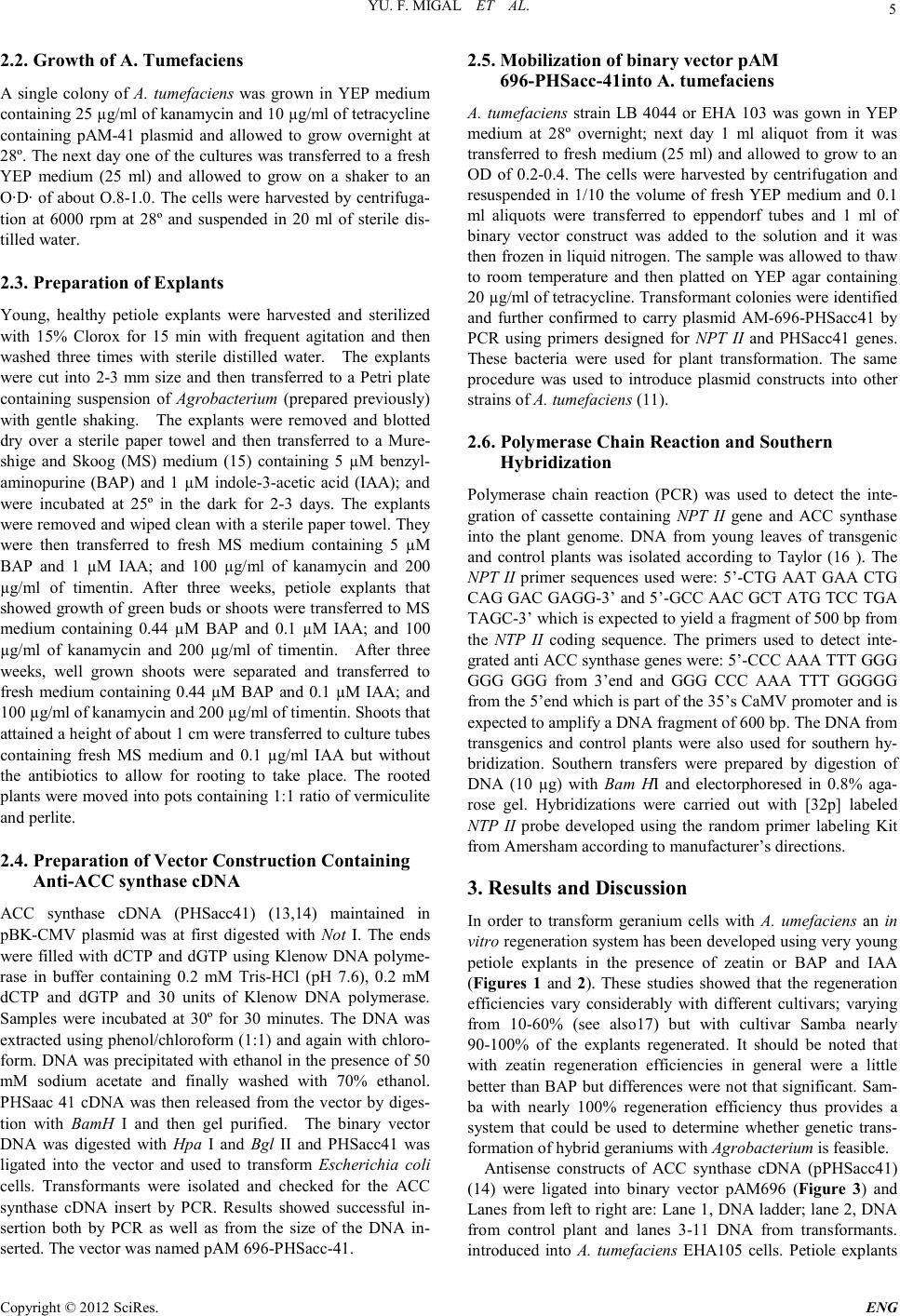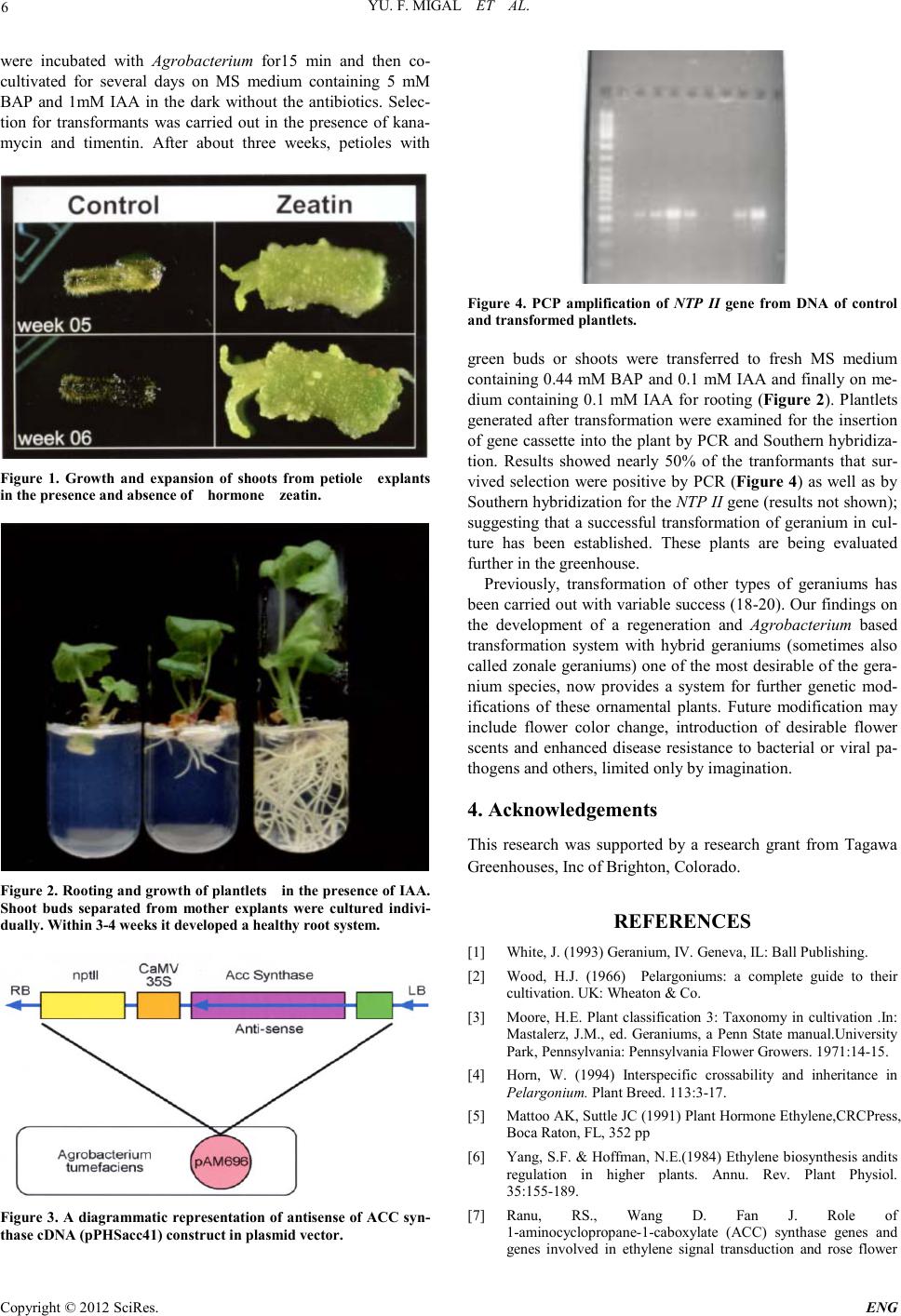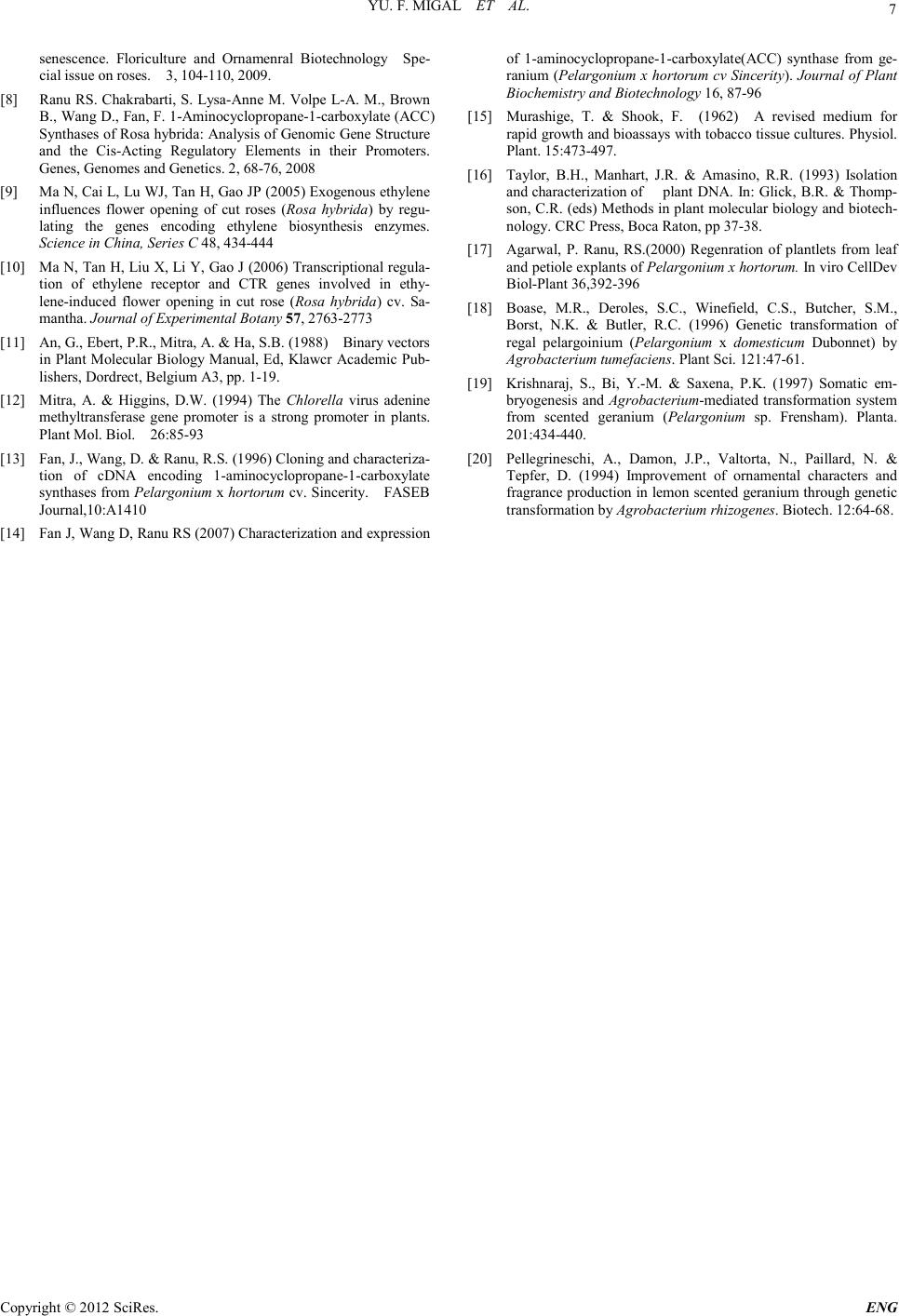Paper Menu >>
Journal Menu >>
 Engineering, 2012, 5, 4-7 doi:10.4236/eng.2012.410B002 Published Online October 2012 (http://www.SciRP.org/journal/eng) Copyright © 2012 SciRes. ENG Agrobacterium Tumefaciens Based Transformation of Pelargonium x Hortrum cv. ‘Samba’ with An- ti-1-aminocyclopropane-1-carboxylate Synthase cDNA t o Re- gulate Ethylene Biosynthesis Rajinder S. R anu1, Jianguo Fan1, Sarada Krishnan1, Pradeep Agarwal1, Amitva Mitra2 1Colorado Sate University, Laboratory of Plant Molecular Biology/Biotechnology, Fort Collins, CO USA 2Department of Plant Pathology, The University of Nebraska, Lincolin, NE USA Email: rranu@lamar.colostate.edu Received 2012 ABSTRACT Phytohormone, ethylene plays an important role in plant growth and development including fruit ripening and flower senescence. The synthesis of 1-aminocylo-propane-1- carboxylate (ACC), the immediate precursor of ethylene, from S-adenosyl-methionine is catalyzed by AC C s ynthase; and which is also a rate limiting step in the ethylene biosynthetic pathway. Therefore, it plays a key role in ethylene biosynthesis and the genes that code for ACC synthase are of special interest. Moreover, in zonal geraniums, ethylene bursts rel eased from cuttings can have profound impact on the viability of explants for plant propagation. Biotechnological approach involving genetic modification that may reduce ethylene levels has potential for increasing the shelf-life of cuttings for plant propa- gation . These con sid erat ions have led us to clone sever al cDNA of ACC synth ase gen es fro m Pel argon ium x hor toru m cv. ‘Sincerity’. To transform geranium cells with Agrobacterium tumefaciens an in vitro regeneration system was developed using very young peti- ole explants. An Antisense construct of ACC synthase cDNA (PHSacc41) ligated into binary vector pAM696 was introduced into A. tumefaciens EHA 105 cells. Petiole explants were incubated with the Agrobacterium for 15 min and then co-cultivated for several days on MS medium containing 5 mM BAP and 1 mM IAA in the dark without the antibiotics. Selection for transformants was car- ried ou t in the presence o f kanamycin and timenti n. Tran sgenic pl antlets gen erated were examin ed for in serted gen e cassette by PCR and Southern blotting. Recovery of positive transformants that survived selection suggested that it is possible to transform and intro- duce genes via transformation in hybrid geraniums for genetic modification. Keywords: ACC Synthase; Ethylene Biosynthesis; Transformation; Geranium Regeneration; Agrob a cteri um Tume faciens 1. Introduction Pelargonium sp., popularly known as geraniums are grown for their colorful flowers and to a limited extent for their scented foliage. They are important ornamental plants that are widely grown in North America and Europe [1-3]. Because of their spectacular flowers P. zonale hybrids are some the most important varieties and command a substantial portion of the market share of over $300 millions. Unlike seed geraniums, hybrid varieties are vegetatively propagated [2,3], therefore, improvements through conventional breeding are difficult and time-consuming [4]. Contemporary plant biotechnology provides a potential alternative to conventional breeding through genetic modification for plant improvement with potential for savings in time and cost to the growers. The phytohormone, ethylene plays an important role in plant growth and development including fruit ripening and flower senescence [5-10]. In geraniums ethylene bursts released by plants during shipping (stress) and when cuttings are prepared for vegetative propagation are a major source of losses to growers (1). Genetic modification may provide a potential means by which ethylene bursts in the plants may be regulated either through antigene technology or through modification of a key gene(s) promoter(s). In the present investigation we have attempted to develop an Agrobacterium tumefaciens based transfor mation system in the vegetatively propagated geranium with an anti-1-aminocyclopropane-1-carboxylate (ACC) syn- thase cDNA con str uct in a Agrobacterium binary vector [11,12] using a plant regeneration system developed for vegetatively propagated geraniums. Our rationale being, that ACC synthase catalyses the rate limiting step in the ethylene biosynthetic pathway [6] and modulation of this step may result in regula- tion of ethylene biosynthesis. These considerations had previ- ously led us to the cloning of several cDNA of ACC synthase genes from P x hortorum cv. ‘Sincerity’ [13,14]. Results from the present studies show that transformants which survived kanamycin selection show integration of NPT II gene in trans- genic plants both by PCR analysis and by southern hybridiza- tion. 2. Materials and Methods 2.1. Explants and Ba c terial Str ains Petioles of very young leaves were used as explants from P. x hortorum cv. ‘Samba’ (provided by Pelfi Fisher Geranium USA, Boulder Colorado). The bacterial strains of Agrobacte- rium tuma feciens, LBA 4404 or LBG 66 or EHA 105 were used.  YU. F. MIGAL ET AL. Copyright © 2012 SciRes. E NG 5 2.2. Growth of A. Tumefaciens A single colony of A. tumefaciens was gro wn in YEP medium containing 25 µg/ml of kanamycin and 10 µg/ml of tetracycline containing pAM-41 plasmid and allowed to grow overnight at 28º. The next day one of the cultures was transferred to a fresh YEP medium (25 ml) and allowed to grow on a shaker to an O∙D∙ of about O.8-1.0. The cells were harvested by centrifuga- tion at 6000 rpm at 28º and suspended in 20 ml of sterile dis- tilled water. 2.3. Preparation of Explants Young, healthy petiole explants were harvested and sterilized with 15% Clorox for 15 min with frequent agitation and then washed three times with sterile distilled water. The explants were cut into 2-3 mm size and then transferred to a Petri plate containing suspension of Agrobacterium (prepared previously) with gentle shaking. The explants were removed and blotted dry over a sterile paper towel and then transferred to a Mure- shige and Skoog (MS) medium (15) containing 5 µM benzyl- aminopurine (BAP) and 1 µM indole-3-acetic acid (IAA); and were incubated at 25º in the dark for 2-3 days. The explants were remov ed and wiped cl ean wi th a ster ile pap er towel. Th ey were then transferred to fresh MS medium containing 5 µM BAP and 1 µM IAA; and 100 µg/ml of kanamycin and 200 µg/ml of timentin. After three weeks, petiole explants that showed growth of green buds or shoots were transferred to MS medium containing 0.44 µM BAP and 0.1 µM IAA; and 100 µg/ml of kanamycin and 200 µg/ml of timentin. After three weeks, well grown shoots were separated and transferred to fresh medium containing 0.44 µM BAP and 0.1 µM IAA; and 100 µg/ml of kanamycin and 200 µg/ml of timentin. Shoots that attain ed a heigh t of abou t 1 cm were transferred to cultu re tubes containing fresh MS medium and 0.1 µg/ml IAA but without the antibiotics to allow for rooting to take place. The rooted plants were moved into pots containing 1:1 ratio of vermiculite and perlite. 2.4. Preparation of Vector Construction Containing Anti-ACC synthase cDNA ACC synthase cDNA (PHSacc41) (13,14) maintained in pBK-CMV plasmid was at first digested with Not I. The ends were filled with dCTP and dGTP using Klenow DNA polyme- rase in buffer containing 0.2 mM Tris-HCl (pH 7.6), 0.2 mM dCTP and dGTP and 30 units of Klenow DNA polymerase. Samples were incubated at 30º for 30 minutes. The DNA was extracted using phenol/chloroform (1:1) and again with chloro- form. DNA was preci pitated with ethanol in the presence o f 50 mM sodium acetate and finally washed with 70% ethanol. PHSaac 41 cDNA was then released from the vector by diges- tion with BamH I and then gel purified. The binary vector DNA was digested with Hpa I and Bgl II and PHSacc41 was ligated into the vector and used to transform Escherichia coli cells. Transformants were isolated and checked for the ACC synthase cDNA insert by PCR. Results showed successful in- sertion both by PCR as well as from the size of the DNA in- serted. The vector was named p AM 696-PHSacc-41 . 2.5. Mobilization of binary vector pAM 696-PHSacc-4 1 into A. tumefaciens A. tumefaciens strain LB 4044 or EHA 103 was gown in YEP medium at 28º overnight; next day 1 ml aliquot from it was transferred to fresh medium (25 ml) and allowed to grow to an OD of 0.2-0.4. The cells were harvested by centrifugation and resuspended in 1/10 the volume of fresh YEP medium and 0.1 ml aliquots were transferred to eppendorf tubes and 1 ml of binary vector construct was added to the solution and it was then frozen in liquid nitrogen. The sample was allowed to thaw to room temperature and then platted on YEP agar containing 20 µg/ml of tetracycline. Transformant colonies were identified and further confirmed to carry plasmid AM-696-PHSacc41 by PCR using primers designed for NPT II and PHSacc41 genes. These bacteria were used for plant transformation. The same procedure was used to introduce plasmid constructs into other strains of A. tu m efacien s (11). 2.6. Polymerase Chain Re action and So uthern Hybridizat ion Polymerase chain reaction (PCR) was used to detect the inte- gration of cassette containing NPT II gene and ACC synthase into the plant genome. DNA from young leaves of transgenic and control plants was isolated according to Taylor (16 ). The NPT II primer sequences used were: 5’-CTG AAT GAA CTG CAG GAC GAGG-3’ and 5’-GCC AAC GCT ATG TCC TGA TA GC-3’ which is expected t o yield a fragment of 50 0 bp from the NTP II coding sequence. The primers used to detect inte- grated an ti ACC synth ase gen es were: 5 ’-CCC AAA TTT GGG GGG GGG from 3’end and GGG CCC AAA TTT GGGGG from the 5’end which is part of the 35’s CaMV promoter an d is expected to amplify a DNA fragment of 600 bp. The DNA from transgenics and control plants were also used for southern hy- bridization. Southern transfers were prepared by digestion of DNA (10 µg) with Bam HI and electorphoresed in 0.8% aga- rose gel. Hybridizations were carried out with [32p] labeled NTP II probe developed using the random primer labeling Kit from Amersham according to manufacturer’s directions. 3. Results and Discussion In order to transform geranium cells with A. umefaciens an in vitro regeneration system has been developed using very young petiole explants in the presence of zeatin or BAP and IAA (Figures 1 and 2). These studies showed that the regeneration efficiencies vary considerably with different cultivars; varying from 10-60% (see also17) but with cultivar Samba nearly 90-100% of the explants regenerated. It should be noted that with zeatin regeneration efficiencies in general were a little better than BAP but differences were not that significant. Sam- ba with nearly 100% regeneration efficiency thus provides a system that could be used to determine whether genetic trans- formation of hybrid geraniums with Agrobacterium is feasible. Antisense constructs of ACC synthase cDNA (pPHSacc41) (14) were ligated into binary vector pAM696 (Figure 3) and Lanes fro m left to right are: Lane 1, DN A ladder; l ane 2, DNA from control plant and lanes 3-11 DNA from transformants. introduced into A. tumefaciens EHA105 cells. Petiole explants  YU. F. MIGAL ET AL. Copyright © 2012 SciRes. ENG 6 were incubated with Agrobacterium for15 min and then co- cultivated for several days on MS medium containing 5 mM BAP and 1mM IAA in the dark without the antibiotics. Selec- tion for transformants was carried out in the presence of kana- mycin and timentin. After about three weeks, petioles with Figure 1. Growth and expansion of shoots from petiole explants in the presence and abs ence of horm on e zeat in. Figure 2. Rooting and growth of plantlets in the presence of IAA. Shoot buds separated from mother explants were cultured indivi- dually. Within 3-4 weeks it developed a healthy root system. Figure 3. A diagrammatic representation of antisense of ACC syn- thase cDNA (pPHSacc41 ) construc t in plas mid vector. Figure 4. PCP amplification of NTP II gene from DNA of control and transformed plantl ets. green buds or shoots were transferred to fresh MS medium containing 0.44 mM BAP and 0.1 mM IAA and finally on me- dium containing 0.1 mM IAA for rooting (Figure 2). Plantlets generated after transformation were examined for the insertion of gene cassette i nto the plant by PCR and Southern hybridiza- tion. Results showed nearly 50% of the tranformants that sur- vived selection were positive by P CR (Figure 4) as well as by Southern hybridization for the NTP II gene (results not shown); suggesting that a successful transformation of geranium in cul- ture has been established. These plants are being evaluated further in the greenhouse. Previously, transformation of other types of geraniums has been carr ied out with variable success (18-20). Our findings on the development of a regeneration and Agrobacterium based transformation system with hybrid geraniums (sometimes also called zo nale geraniums) on e of the most desirable of the gera- nium species, now provides a system for further genetic mod- ifications of these ornamental plants. Future modification may include flower color change, introduction of desirable flower scents and enhanced disease resistance to bacterial or viral pa- thogens and others, limited only by imagination. 4. Acknowledgements This research was supported by a research grant from Tagawa Greenhouses, Inc of Brighton, Colorado. REFERENCES [1] White, J. (1993) Geranium, IV. Geneva, IL: Ball Publishing. [2] Wood, H.J. (1966) Pelargoniums: a complete guide to their cultivation. UK: Wheato n & Co. [3] Moore, H.E. Plant classification 3: Taxonomy in cultivation .In: Mastalerz, J.M., ed. Geraniums, a Penn State manual.University Park, Pennsylvania: Pennsylvania Flower Growers. 1971:14-15. [4] Horn, W. (1994) Interspecific crossability and inheritance in Pelargonium. P l an t Bree d. 113:3-17. [5] Mattoo AK, Suttle JC (1991) Plant Hormone Ethylene,CRCPress, Boca Rato n, FL, 352 pp [6] Yang, S.F. & Hoffman, N.E.(1984) Ethylene biosynthesis andits regulation in higher plants. Annu. Rev. Plant Physiol. 35:155-189. [7] Ranu, RS., Wang D. Fan J. Role of 1-aminocyclopropane-1-caboxylate (ACC) synthase genes and genes involved in ethylene signal transduction and rose flower  YU. F. MIGAL ET AL. Copyright © 2012 SciRes. E NG 7 senescence. Floriculture and Ornamenral Biotechnology Spe- cia l is s ue on roses. 3, 104-110, 2009. [8] Ranu RS. Chakrabarti, S. Lysa-Anne M. Volpe L-A. M., Brown B., Wang D., Fan, F. 1-Aminocyclopropane-1-carb oxylat e (AC C) Synthases of Rosa hybrida: Analysis of Genomic Gene Structure and the Cis-Acting Regulatory Elements in their Promoters. Genes , Gen o mes a nd Genetics. 2, 68-76, 2008 [9] Ma N, Cai L, Lu WJ, Tan H, Gao JP (2005) Exogenous ethylene influences flower opening of cut roses (Rosa hybrida) by regu- lating the genes encoding ethylene biosynthesis enzymes. Scie nce in Ch i na , Ser ies C 48, 434-444 [10] Ma N, Tan H, Liu X, Li Y, Gao J (2006) Transcriptional regula- tion of ethylene receptor and CTR genes involved in ethy- lene-induced flower opening in cut rose (Rosa hybrida) cv. Sa- mantha. Journal of Experimental Botany 57, 2763-2773 [11] An, G., Ebert, P.R., Mitra, A. & Ha, S.B. (1988) Binary vectors in Plant M olecula r Biology Manual, Ed, Klawcr Academic Pub- lisher s , Dor drect, Bel g ium A 3, p p. 1-19. [12] Mitra, A. & Higgins, D.W. (1994) The Chlorella virus adenine methyltransferase gene promoter is a strong promoter in plants. Plant Mol. Biol. 26:85-93 [13] Fan, J., Wang, D. & Ranu, R.S. (1996) Clon ing an d cha ract eri za- tion of cDNA encoding 1-aminocyclopropane-1-carboxylate synthases from Pelargonium x hortorum cv. Sincerity. FASEB Journal,10:A1410 [14] Fan J, Wang D, Ranu RS (2007) Characterization and expression of 1-aminocyclopropane-1-carboxylate(ACC) synthase from ge- ranium (Pelargonium x hortorum cv Sincerity). Journal o f Plant Bioc hemistry and Biotec hnology 16, 87-96 [15] Murashige, T. & Shook, F. (1962) A revised medium for rapid growth and bioassays with tobacco tissue cultures. Physiol. Plant. 15:473-497. [16] Taylor, B.H., Manhart, J.R. & Amasino, R.R. (1993) Isolation and char acteriza tion of plant DNA. In: Glick, B.R. & Thomp- son, C.R. (eds) Methods in plant molecular biology and biotech- nology. C RC Press , Boca Rat on, pp 37-38. [17] Ag arwal, P. Ranu, RS.(2000) Regenration of plantlets from leaf and p etiole exp la nt s of Pelargonium x hortorum. In viro CellDev Biol-Plant 3 6,392-396 [18] Boase, M.R., Deroles, S.C., Winefield, C.S., Butcher, S.M., Borst, N.K. & Butler, R.C. (1996) Genetic transformation of regal pelargoinium (Pelargonium x domesticum Dubonnet) by Agrobacterium tumefaciens. Plant Sci. 121:47-61. [19] Krishnaraj, S., Bi, Y.-M. & Saxena, P.K. (1997) Somatic em- bryogenesis and Agrobacterium-mediated transformation system from scented geranium (Pelargonium sp. Frensham). Planta. 201:434-440. [20] Pellegrineschi, A., Damon, J.P., Valtorta, N., Paillard, N. & Tepfer, D. (1994) Improvement of ornamental characters and fragrance production in lemon scented geranium through genetic transformat ion by Agrobacterium rhizogenes. Biotech. 12 :6 4-68. |

